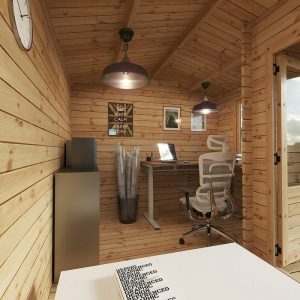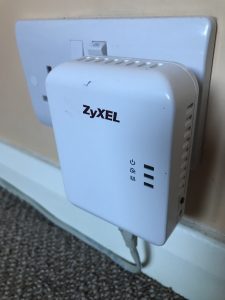 Other than a kettle, a garden office would be lost without a reliable internet connection.
Other than a kettle, a garden office would be lost without a reliable internet connection.
The easiest solution would be to extend the Wi-Fi signal from your broadband router in your house to the office.
The disadvantage of this, however, is that in a majority of cases the signal won’t be strong enough to reach.
Or, if it does, it would be very weak and unreliable which would make it difficult to work – resulting in much swearing no doubt :-/
Here are some solutions that will overcome this:
Wi-Fi Extender
- A way of connecting your existing Wi-Fi network and extending the signal.
- This creates a hotspot or bridge between the main router and the log cabin.
- Plug the extender into a mains socket in your house that is as near to the cabin as possible.
- This will “bounce” the signal and creates an additional Wi-Fi network which you can connect to in the cabin.
- Advantages: Cheap and quick to install
- Disadvanges: Effective within a relatively short range – around 30m- so only suitable for garden offices close to the house
- Price range: £20 – £50 See NETGEAR Wi-Fi Range Extender **
Wi-Fi Point to Point
- Similar to a Wi-Fi extender but more advanced.
- Two units are required – one attached to your house and one attached to your log cabin.
- The unit attached to your house is connected to your home Wi-Fi network.
- This transmits a signal to the second unit on your log cabin.
- It’s important there is a clear line of sight between the two units for the signal to work most efficiently and prevent interference from trees, shrubs and other garden buildings.
- Advantages: Reliable and effective with a greater range over longer distances compared with a Wi-Fi extender
- Disadvantages: More expensive option as it is slightly more involved to install – some configuration may be needed – so will probably require a professional (newer systems, however, are available already configured which would enable you to get connected a lot easier).
- Price range: £100+
Powerline Networking
- A simple way to get internet connection in your log cabin.
- Creates a secondary network built on your home’s existing system.
 Powerline adapters send the signal from your router through your cabin’s electricity supply by an electric power cable between your house and the cabin.
Powerline adapters send the signal from your router through your cabin’s electricity supply by an electric power cable between your house and the cabin.
- Consists of 2 adapters and 2 ethernet (also known as network) cables.
- Plug one adapter into a socket in your house and use the ethernet cable supplied to connect it to the WiFi router – this allows the network data to travel via the electrical system to the receiving adapter in the cabin.
- Plug the second adapter into a socket in the log cabin and use the ethernet cable to attach it to your computer or cabin-based WiFi router for a wireless connection.
- Advantages: Relatively cheap and easy to install generally not requiring professional installation
- Disadvantages: Only works if the electricity supply in the log cabin comes from the same distribution box as your house.
- Price range: £20 – £50 See Powerline Adapter Starter Kit **
Ethernet Cable
-
An ethernet cable is run from your internet router in the house to the log cabin.
-
This can be plugged directly into a PC or laptop, or into a switch for connecting multiple devices, or into another Wi-Fi router.
- It would be make sense to run the ethernet cable at the same time as the power cables when supplying electricity to the log cabin ensuring there is a 30cm gap between the power and ethernet cables to prevent interference, especially over a long distance.
- Make sure the exposed cable between the house and log cabin is buried deep underground so there’s no danger of it being accidentally severed by digging – as a precaution, this may require a professional installation.
- Advantages: Considered the best option for a reliable, fast and secure internet connection.
** Please note we are not IT specialists and these are just suggestions
